Ask a question from expert
BIM Impact on the Cost Overruns in Infrastructure Projects in Australia
38 Pages12742 Words452 Views
Added on 2020-10-04
BIM Impact on the Cost Overruns in Infrastructure Projects in Australia
Added on 2020-10-04
BookmarkShareRelated Documents
BIM impact on the cost overruns in infrastructure projects in Australia1 | P a g e

1.IntroductionThe limitations of the existing traditional approaches to managing present complex constructionprojects have resulted in a low performance in many aspects of the project management, especially whenit comes to cost and time which are key factors for the project success. Cost overruns possess a significantrisk to the construction industry and the magnitude of cost overrun has not been improved and learninghas not identified to mitigate this risk (Allahaim and Liu, n.d.). Studies suggested that contractors’capability to estimate the cost and utilize tools for that purpose exhibits the cost-related performance ofprojects in the construction industry (Doloi, 2012).The construction industry since from last few years has been long criticised because of its poorperformance and inefficiency, as a resulted cost overruns is considered as a norm, Verweij (2015).According to Shehu et al. (2014), the cost overruns in a construction project can lead to conflicts,litigations and in severe cases abandoning of the project. Hence, the cost is considered as an importantfactor in determining the success of projects especially related to infrastructure. The cost associated withconstruction projects are categorised as direct and indirect cost that are both affected by cost overruns.This could result in financial losses for contractors and/ clients and could possibly hinder economicgrowth of the region. (Alabdulqader et al., 2013; Kraatz et al., 2014) claimed that, traditional managementis the major reason for cost overruns. These cost-related issues with the traditional management in theconstruction industry include 60%–90% of variations due to poor documentation and 5%–10% of theincrease in construction cost due to lack of communication.Building Information Modelling (BIM) has been rapidly emerging as a capable technology, forming anintegrated platform that can potentially improve the performance of the construction industry. BIMrepresents a collaborative methodology to manage the project information throughout its lifecycle. Thedistinctive idiosyncrasy of BIM is the ability to create, view and extract not only the geometric data of thebuilding but also non-geometric dates such as cost and time. For instance, the 5D (cost) BIM modelassociated with 3D and 4D (Time) allows participants to review and analyses the project progress andrelated cost. Building Information Management is a tool that can be used to estimate the cost associatedwith projects at different stages to avoid cost overruns. BIM can provide cost estimations for the projectduring different phases to overcome cost overruns.With such benefits, this research project seeks to establish a comprehensive review of the literature and toexamine the current construction industry practices in relation to cost overruns in Australia and thepotential impact of BIM technology to improve cost performance of construction projects. Particularly,the research has the following sub-objectives: 2 | P a g e
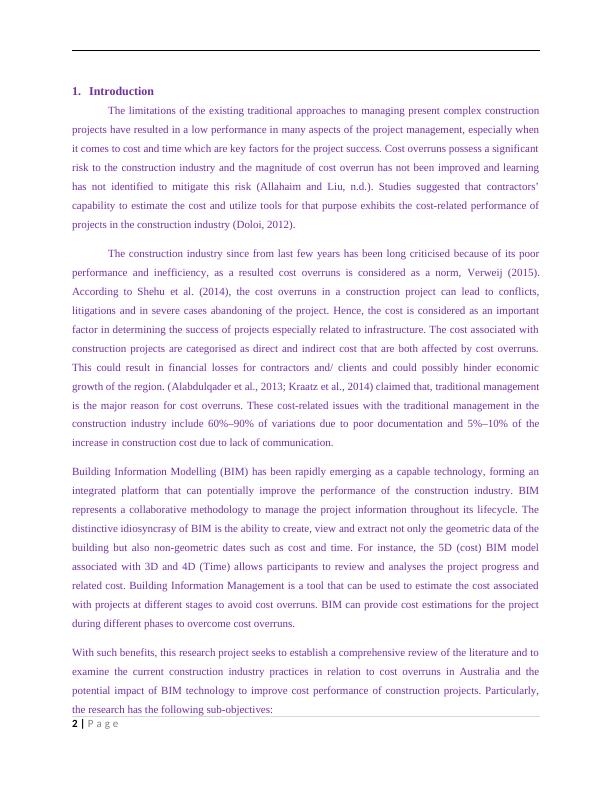
1.To review the current state of BIM implementation in project management of infrastructureprojects within construction industry with a focus on the cost management process. 2.To explore the fundaments and key factors for cost overruns occurring in project management ofinfrastructure projects within the construction industry. 3.To investigate the potential BIM contribution to improving cost performance.1.1Research design:The research philosophy which is preferred for this research is positivism due to the objectivenature of the research. This research requires numeric data to identify the impact of BIM on infrastructureprojects in Australia; therefore, quantitative method of the research is considered by the scholar. BIMimplementation is affected by several participants at different levels of the project organisation. Theeffect of BIM implementation is extending to a wide range of interrelated aspects. Therefore, electronicsurvey questionnaires will be one of the most effective methodology to cover a large sample ofprofessional organisations in the construction industry. The survey questionnaires will be sent to theemployees of the firms involved in project management of infrastructure projects located in Australia. The present research will contribute knowledge to the profession by reviewing BIM implementationpractices, challenges and benefits to cost performance. The result of this research will be valuable to theconstruction industry participants, with a particular focus on the cost aspects of project management ofinfrastructure projects along with the reflection on the construction industry performance.3 | P a g e
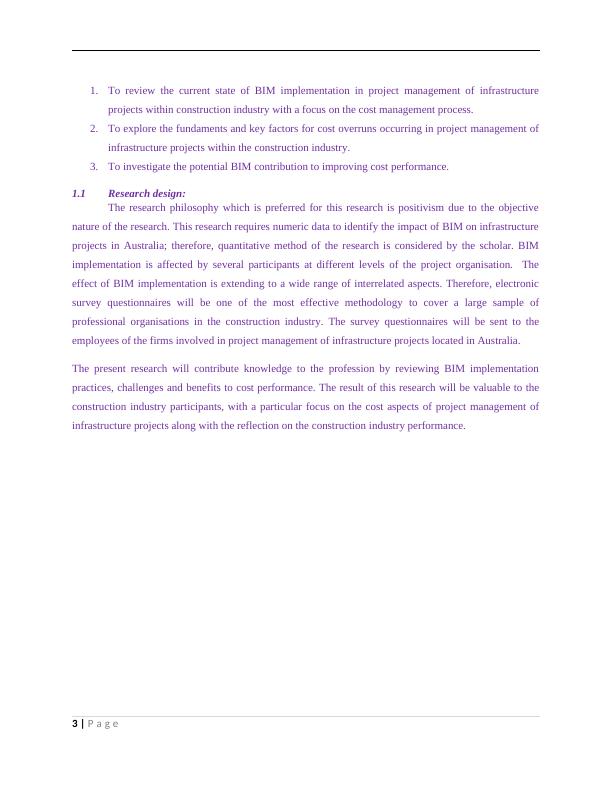
2.Literature reviewThis section presents an overview of BIM implementation and cost overruns through consideration ofideas and identified shortfalls from previously published papers, articles, reports and books.2.1. Cost overruns in construction projects in AustraliaCost overrun is defined as the excess of actual cost over budget. Such cost overruns can be daunting forparties involved in construction projects and could lead to significant financial losses, penalties andlitigations. (Flyvbjerg, 2007) conducted a study in Denmark, to evaluate the accuracy of cost estimates onlarge-scale infrastructure projects. The study concluded that overruns above 100% are usual and costoverrun of 50– 100% is common for larger infrastructures. On average, the cost overruns around theglobe for infrastructure projects such as bridges, roads and rail are around 33.8 %, 20.4% and 44.7%respectively (Flyvbjerg et al., 2005). The study conducted by Maher and McGoey-Smith (2006) cited byRamabodu and Verster, (2010), evaluated that cost overruns are independent of geographic location, 90%of projects suffer underestimation of cost in the initial phase and the percentage-overrun increases withthe size of the project.The performance of construction industry in Australia is based on cost and duration are pitiable. Forinstances, the original contract value for the Western Australian Perth Arena was AU$168 million. Theactual cost at completion was three times more than this value. Further, it was completed three years afterthe original planned completion date. Moreover, Ramabodu and Verster, (2010) and Terrill and Danks,(2016) claimed that many large rail projects have experienced significant cost overruns such as Sydneylight rail, the Gold Coast light rail and Perth-Mandurah rail line. Deloitte Access Economics 2014reported that Australian construction cost for infrastructure projects has increased rapidly due to GlobalFinancial Crisis (GFC), which resulted in a rise in engineering cost. This has resulted in an increase inwage rate of the people involved in construction projects and there is no pullback in the wage system.Moreover, in the last eight years from 2014, the cost overruns for the construction projects increased by6.5% and the cost overruns are visible for larger projects. Although cost overruns are considered as asignificant risk to the construction industry, (Allahaim and Liu) claimed that yet the magnitude of costoverruns has been improved. According to the view of author building information modeling is becoming a comprehensivecollaborative process within the construction industry. Author argued that BIOM has had an enhancinggrowth in the last decade. It happens because of its capabilities on construction projects. It can easilydevelop a common language for all the parties and system divisions within a project and assist in making4 | P a g e
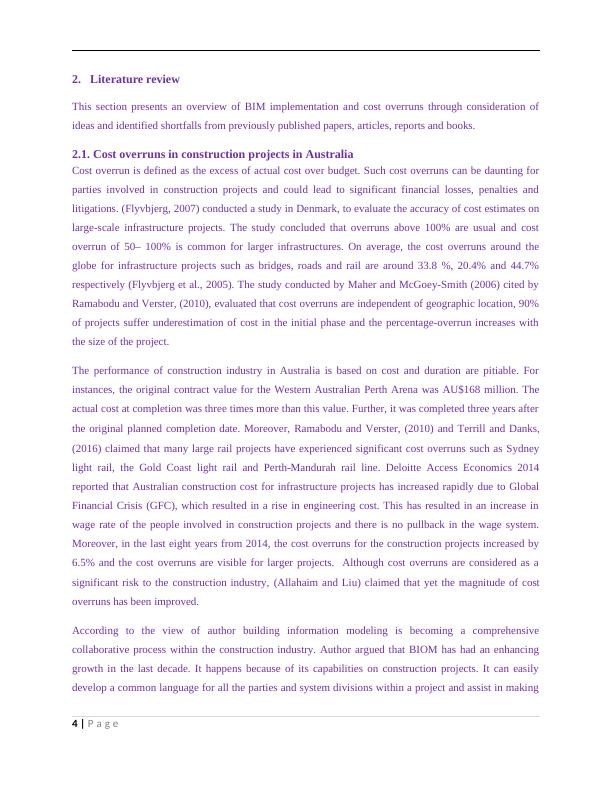
a integrated team. Author critically analyzed that approach of BIM strongly matches with integratedproject at the time of delivering system. 2.2. Factors influencing cost overruns in construction projectsIt is an unquestionable fact that delays in almost all construction projects could occur due to miss-communication among different parties involved in projects (Kaliba, Muya and Mumba, 2009). Themajor reasons for such delays are the inaccurate estimation of the project cost and time that result in costoverruns (Akintoye and Fitzgerald 2000). The role of project manager in such situation is extremelyimportant. They have the authority to manage the communication among different parties withinconstruction project from the beginning to end. Factors influencing cost overruns in the constructionindustry were widely investigated by the researchers aiming to rank the most significant factors accordingto their importance. Morris (1990) examined and identified four key causes of cost overruns: poorplanning, design changes, material prices fluctuation and unforeseen weather conditions. Shah (2016)cited a study by Arditi (1985) about the main factors for delay and cost overruns in construction projectsin Turkey, as follows: inflation, design changes and underestimation of the original project cost. Thestudy conducted by Allahaim and Liu (n.d.) identified inadequate planning and control, market andregularity uncertainty, site condition and scope change as the factors influencing cost overruns in KSA.The factors influencing cost overruns in Ghana are payment delays, inaccuracy of projects’ costestimation and complexity of the project (Shah, 2016). According to Shah (2016), the main factors thatincrease the probability of cost overruns in Australian projects are deficiencies in planning andscheduling, construction methods, monitoring and feedback. The difference in factors influencing the costoverruns in construction projects indicated that they are dependent on geographical locations and facilitiesassociated with these locations.2.3 Cost overruns in infrastructure projects in AustraliaThe infrastructure projects deal with providing necessities to people in the form of physical constructionsuch as rails, roads, bridges and tunnels, sewage systems etc. These projects are generally long-termprojects and are associated with high cost. According to the findings of Maher and McGoey-Smith(2006), the greater the size of the project, the larger would be the cost overrun. Therefore, it is anticipatedthat infrastructure projects tend to have a high cost overrun. Terril, Coates and Danks (2016) conducted a research in which Australian transport-related infrastructureprojects by the government were analysed for understanding cost overruns causes. For this purpose, thetransport related infrastructure projects from 2001 to 2015 were evaluated. The research concluded thatAustralian transport infrastructure programs exceeded $20 million of the expected cost (Terril, Coates and5 | P a g e
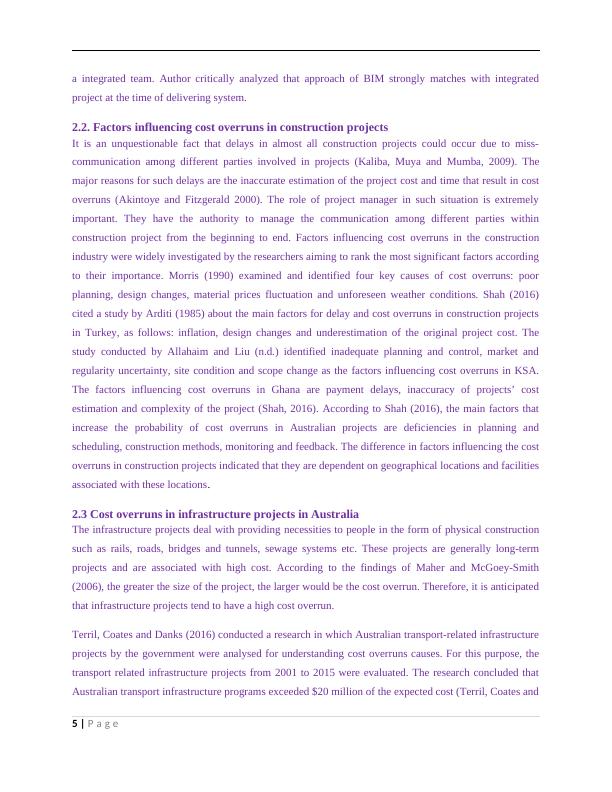
Danks, 2016). Moreover, there was no evidence found for project appraisal process for such projects. Thisalso affects the future infrastructure projects by causing uncertainties in decision-making and managingprocesses. According to Coultan (2016), the series of infrastructure projects in Australia are heavilyaffecting the taxpayers as well as hinders future projects.To evaluate the cost overruns for infrastructure projects in Australia; Creedy, Skitmore and Wong (2010)studied highway projects in Australia. They were able to find a positive relationship between the size ofthe project and overall cost overruns. It is identified that the highway projects in Australia suffer costoverruns due to uncertain (uncontrollable) factors as compared to risk (controllable factors). The factorsthat result in cost overruns in Australian highway projects are project type, construction material cost, thelocation of the project and project’s delivery method.Similarly, Doloi (2012) conducted a research to understand the cost overruns occur due to the failure ofproject management in Australia industry. Reason for conducting this research is to identify the cause offailure from the perspective of key stakeholders including consultant, client and contractor. Doloi claimedthat the project management plays an important role in the success of the project as they manage thecritical relationship between major stakeholders of the project. He also indentified the five significantfactors that could reduce the chances of cost overruns in Australian projects are top-notch projectplanning and monitoring, effective site management, the efficiency of contractors, the efficiency ofdesign and communication. 2.4. Traditional practices to deal with cost overruns With the complexity, uniqueness and fragmented nature of construction projects it have access tocoordinated and accurate information is pivotal for project management and performance. (Kraatz et al.,2014) described the traditional 2D delivery model being used in infrastructure projects as “hierarchical,fragmented, linear and prone to promoting adversarial behaviour across the supply chain”. (Yalcinkayaand Arditi, 2013) argued that the two-dimensional delivery system is an insufficient method ofcommunication and falls short in monitoring complex projects. The poor collaboration amongst the teamand lack of integration of the design elements resulted in a lot of projects becoming behind schedule and/or over budget. Lack of adequate information has always contributed to poor productivity and rework, which in turnresult in cost overruns and delays (Matthews et al., 2015). The construction industry is still largely relyingon the 2D CAD-based application to generate the design and construction documents. This involves6 | P a g e

sharing of sheets among different parties involved in the project that are manually handled and results invarious inaccuracies and improper project management (Abbasnejad et al., 2016).According to Young, Hosseini and Lædre (2016), the Australian infrastructure projects also utilisetraditional practices, which are resulting in high cost overrun in projects. It is believed that inaccuraciesand conflicts are also present in BIM models but the processing time is far less as compared to traditionalmodels (Smith, 2014). Engineers Australia identified the lack of integration along the supply chainthrough the project life cycle as the most notable issue, promoting the need for BIM (Alabdulqader et al.,2013). 2.5. BIM contribution to control cost overrunsGenerally, BIM adoption has been referred as one of the most effective solutions for many of theconstruction industry challenges. Succar, (2009) argued that the emerging BIM technology represents aframework to manage the building information through the building lifecycle. BIM can be a catalyst forindustry transformation, reduce fragmentation, reduce cost and improve the efficiency. (Love et al., 2017) acknowledged the potential reduction of cost overruns when BIM is applied to railprojects. He stressed that achieving the real benefits of a BIM solution requires collaboration between allparties, particularly when a building information model is utilized during Operations and Maintenance.Kraatz et al., (2014) also claimed that adoption of BIM across the supply chain in Australia could enhancethe industry productivity by 9%. However, (Shah, 2016) argued that BIM may not be sufficient to prevent entire cost overruns and delays.He suggested that past experience and new methods could be used to mitigate recogonised risk factors,particularly in the undeveloped and developing countries. In contrast (ALABDULQADER et al., 2013)argued that the rate of BIM adoption appears to be lower than expected despite the far-reaching benefitsof BIM. (Bryde et al., 2013) also added that the overall effectiveness of BIM utilisation is still yet to becompletely justified. Giel and Issa (2011) also researched BIM implementation impact on the construction industry throughreturn on investment (ROI). For this purpose, they conducted a comparative case study approach thatinvolves collecting information of three companies with similar nature of projects. The researchconfirmed that BIM has a positive impact on the cost overruns and return on investments. The ROI ofimplementing BIM on the three cases is in the range of 16 to 1,654%2.5.1 Coordination and communication7 | P a g e
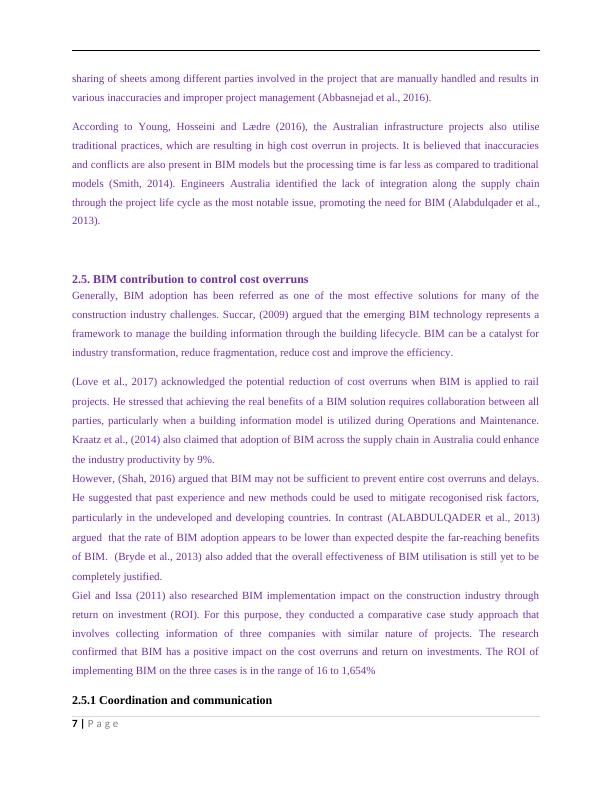
Many researchers believed that BIM improves communication and level of coordination among membersof project management team (Wong and Fan, 2013; Khosrowshahi and Arayici 2012; Coates et al. 2010).The integrated model which furnish many benefits for the projects including improved productivity, clashdetection, resolve conflict and discrepancies early, and an effective method for tracking the changes. Thisintegrated approach for project information will result in time and cost saving during construction as 5%–10% of the increase in construction cost due to lack of communication (ALABDULQADER et al., 2013);(Rokooei, 2015). Based on face-to-face interviews with managers on construction projects focused onRFI’s, rework, change orders and schedule compliance, (Fan et al., 2014) summarised that 79% of therespondents stated there was “very little rework and waiting time” when BIM was used for coordinationof construction work on site. Respondents in the survey believed that they saved 4-7% of project cost,because of the non-issuance of change orders.Rowlinson et al. (2010) conducted a research by focusing on empirical evidence of the impact of BIM onconstruction projects during the construction stage. The research highlighted the positive impact of BIMimplementation on eliminating the conflicts in design as compared to the traditional method. Moreover, italters the roles and responsibilities of the parties involved in such projects, which demand the change inthe culture of the construction-based organisation in which the technology alone cannot fulfil the need.Building on this research, Dongping, Heng and Guangbin (2017) conducted another research in whichthey utilised resource dependent theory for developing and testing a model that explains the impact ofBIM on the construction industry and cost overruns. For this purpose, the researchers deploy quantitativeresearch method and data were collected from the designers and contractors using survey questionnaire.After extensive analysis of the data, they evaluated that BIM implementation improved communicationand collaborative decision-making. 2.5.2. Cost estimation, monitoring, and controlIn very specific terms, Ali et al., (2010) claimed that inaccurate estimation of the original cost is the mostserious cause to cost overrun. He suggested that proper project costing is the most effective method tocontrol the construction projects cost. This includes cost estimates for the project resources and materials.BIM can be used to generate a bill of quantities, and changes in the BIM model can be automaticallypropagated through the whole estimation cycle (Yalcinkaya and Arditi, 2013; Diaz 2016). Azhar et al.,(2008) studied the direct impact on the project cost of BIM implementation and concluded the accuracy incost estimation within 3%, the removal of unbudgeted change up to 40%, a decrease in project time up to7% and a reduction in the time needed for cost estimating up to 80%.8 | P a g e

End of preview
Want to access all the pages? Upload your documents or become a member.
Related Documents
Cost Overruns and Failure in Project Management: Understanding the Roles of Key Stakeholders in Construction Projectslg...
|13
|14788
|76
Roles and Responsibility of BIM Manager on Projectslg...
|7
|1555
|383
Construction Project with BIM Implementation - Kingsly PLC Case Studylg...
|5
|1584
|248
KB7034: Building Information Modelling Managementlg...
|10
|2641
|405
Building information modelling (BIM)lg...
|7
|1682
|20
Building information modelling Report 2022lg...
|18
|8885
|45